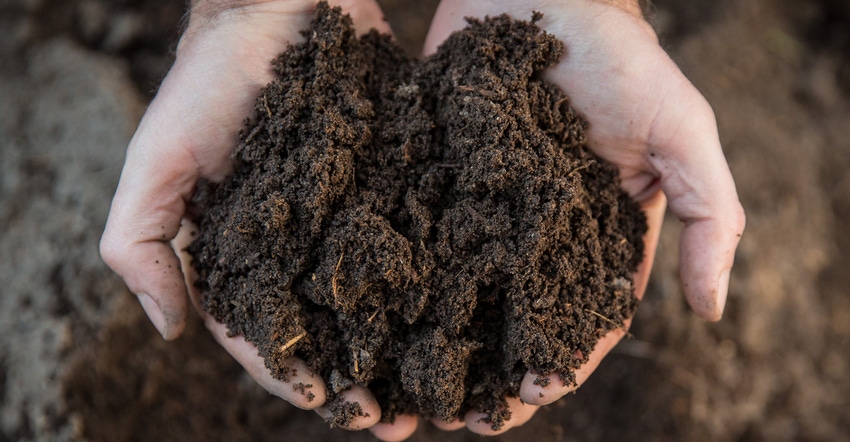
Editor's note: We're introducing a new column for 2022 — Carbon Conversations. Mahdi Al-Kaisi has done extensive research on a range of soil-related issues, including carbon sequestration. In this opening column, he sets the stage for future columns on an issue where many farmers are seeking help.
The current emphasis on agriculture as a part of climate change solutions is highly promising, and emphasizes the critical role of agriculture — not only for food security on the national and global levels, but also as a critical, and one of the most readily available, solution to use for mitigating climate change impacts. Agriculture technologies and management practices are mature and readily available to deploy for CO2 atmospheric removal and to secure storage in agriculture croplands, grasslands and forests, with the most cost-effective solutions compared to other CO2 removal solutions and platforms.
It is important to understand the processes and mechanisms of carbon sequestration, and to define what we mean by carbon sequestration. In the current environment, there is a significant race by the agriculture industry and the private sector to establish carbon credit markets. However, what is lacking in these efforts is the real understanding of what we mean by carbon sequestration — without muddying the waters with other ancillary products being promoted to farmers under the concept of carbon sequestration.
Carbon sequestration is simply a process where plants take CO2 from the atmosphere through the photosynthesis process and convert it into carbohydrates, which are stored in the plants’ aboveground biomass, grains, fruits and root systems. Thus, carbon sequestration is the removal of CO2 from the atmosphere that is secured in storage in plant and soil systems. Any other practices, amendments or products do not fit this definition and can simply be a source of CO2 (i.e., applying manure, other byproducts, etc.) emissions rather than carbon storage or sequestration.
It is simply the soil-plant-atmosphere relationship that reduces CO2 concentration in the air, which contributes to net zero emissions. Amendments and byproducts have a place in improving soil health and resiliency through the enhancement of ecosystem services, such as an increase in water-holding capacity, aggregate stability, water infiltration, etc.
The current efforts on the national and global levels to establish a carbon marketplace are highly needed to provide a mechanism for farmers and industry to be part of the climate challenge solution to achieve net zero emissions and improve soil health.
Several issues to consider
However, these efforts are in the experimental and developmental stages, and the majority are characterized — at best — as exploration to claim a piece of the market following the concept of the “Gold Rush,” with significant scientific and technological challenges for the following reasons:
• Lack of good scientific foundation. There is a lack of good scientific foundation for some of these entities in terms of experienced or skilled individuals on the planning or field levels regarding the understanding of soil carbon dynamics.
• National or regional standards. There should be national or regional standards to guide the development of a carbon market, or a set of procedures and guidelines to manage carbon credit counting and assessments. Therefore, there is an urgent need for the establishment of core principles to ensure high-quality carbon credits, well-defined technical and legal standards, and a cohesion of currently fragmented carbon credit markets in an impactful and well-run system.
• Credible field measurement tech. Credible field measurement technologies and methods of monitoring, recording and verifying of soil carbon change as management practices must be employed, especially in crops and grasslands sensitive enough to detect soil carbon change under different management practices.
• Credible monitoring, reporting, and verification methods There must be credible monitoring, reporting, and verification methods that can provide assurance of carbon credit quality to buyers and sellers of what they are buying and selling.
• Research and development investment. Investment in research and development of new technologies to measure and monitor soil carbon sequestration on a regional scale, to improve accuracy and reduce cost.
• Common and standardized set of agriculture practices. There should be a common and standardized set of agriculture practices that contribute to CO2 sequestration that ensure the quantifiable carbon credits the buyer seeks. These practices must be based on actual scientific and published research.
• Verified, well-established soil carbon baselines. Verification of well-established soil carbon baselines for fields prior to imposition of any management practices for those which will be enrolled in soil carbon credit programs.
• National standard to credit early-established practices. There should be a national standard to credit early-established practices on fields for many years. Those early adopters contributed to CO2 removal and sequestration for many years, accounting for additionality or co-benefits that contributed to enhancing soil health.
• Definition of data ownership. Data ownership must be defined with transparency between carbon credit sellers and buyers. Also, regional data hubs that can be accessible by scientists and the public must be created.
• Farmers must keep records. Farmers need to do their homework and keep accurate records of their operations and management practices prior to and during enrollment in a carbon credit program.
• Work on outreach and capacity-building. Outreach and capacity-building expertise through new national programs must be part of partnership between land-grant Extension, government and state entities and the private sector to provide technical assistance to farmers and industry.
Setting standards for success
It is imperative to establish clear technical and legal standards to govern unified carbon credit markets, providing quality and certainty of carbon credits to both seller and buyer in the private market. Carbon credit providers (i.e., farmers) should explore and investigate the carbon credit opportunities and understand the principal practices that will generally achieve carbon sequestration and generate carbon credits, such as no-till, strip tillage, cover crops, perennial strips, etc., for cropland, just to name a few.
In addition, it is important to keep in mind that the use of conventional tillage in any form will not meet the scientific definition and requirement of carbon sequestration. Any soil disturbance by tillage systems causes soil carbon loss, especially newly sequestered carbon. Understanding these principles in managing fields under carbon credit contracts is critical to continue implementation of CO2 sequestration practices, such as no-till to secure storage of new carbon, which is most sensitive to any form of soil tillage and disturbance.
Most importantly, it should be understood that carbon sequestration in agricultural land is a long-term commitment. It should be approached with that in mind when adopting climate-smart agriculture practices in our cropping systems. Finally, carbon credit providers need to understand the legal and technical terms of the contract, and their rights and obligations under such contract.
Al-Kaisi is a professor emeritus of soil physics (soil management and environment) in the Department of Agronomy at Iowa State University, Ames. His research focuses on the effects of cropping and tillage systems, crop residue management, cover crops and nitrogen application on soil health, soil carbon dynamics, carbon sequestration, greenhouse gas emissions and other ecosystem services. He is a fellow of the American Society of Agronomy, the Soil Science Society of America, and the Soil and Water Conservation Society.
About the Author(s)
You May Also Like






